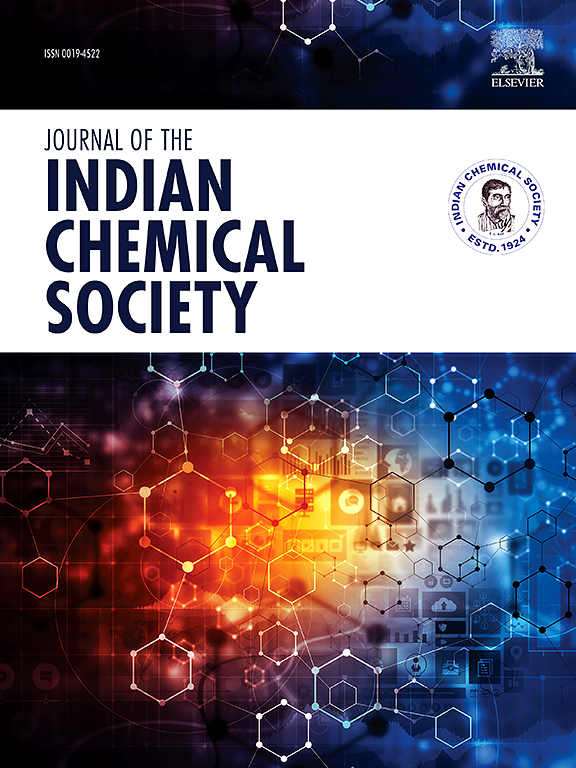Synthesis of Carbonate beta-cyclodextrin nanosponges utilizing choline Chloride-ZnCl2 deep eutectic solvent
IF 3.4
4区 化学
Q2 CHEMISTRY, MULTIDISCIPLINARY
引用次数: 0
Abstract
Carbonate cyclodextrins are a form of nanosponges widely used in several areas, including the pharmaceutical field, because they are non-toxic, stable at high temperatures (up to 300 °C), and exhibit a strong affinity for biological compounds. However, their preparation into petroleum solvents (DMF or DMSO), as well as the time and heating required were the main drawbacks of carbonate cyclodextrin nanosponges (CD-NS). Therefore, it is crucial to prepare CS-NS in an environmental condition and cost-effective method. Thus, CD-NS were obtained by crosslinking beta-cyclodextrin (βCD) and diphenyl carbonate (DPC), for the first time, into deep eutectic solvents (DES) based on choline chloride (ChCl) and zinc chloride (ZnCl2) under microwave irradiations. As an experimental procedure, the preparation of DES was performed under different molar ratios (ChCl:ZnCl2, 1:1, 1:2, 1:4, 2:1). Then, βCD was cross-linked to DPC (1:4 as a molar ratio) under irradiation (80 W) into DES. The four CS-NS obtained were weighted, and particle characteristics of the formulations, crystalline and morphology properties, molecular structure and thermal behavior were thoroughly examined. As a result, yields were comprised between 65.2 % and 13.7 % for the CD-NS formulations 1:2 and 1:4, respectively. Furthermore, the dynamic light scattering studies showed a particle size ranging from 666.9 to 730.4 nm with a narrow size distribution. In addition, powder X-ray diffraction, scanning electron microscope, Fourier transform infrared spectroscopy, and thermogravimetry analysis demonstrated the successful formation of CD-NS. Therefore, preparing carbonate cyclodextrin nanosponges into a deep eutectic solvent under microwave irradiation proved an efficient method with a green solvent and a low-cost process.

利用氯化胆碱-氯化锌深共熔溶剂合成碳酸盐β -环糊精纳米海绵
碳酸盐环糊精是纳米海绵的一种形式,广泛应用于包括制药领域在内的几个领域,因为它们无毒,在高温下稳定(高达300°C),并且对生物化合物具有很强的亲和力。然而,它们在石油溶剂(DMF或DMSO)中的制备,以及所需的时间和加热是碳酸盐环糊精纳米海绵(CD-NS)的主要缺点。因此,在环境条件下和成本效益的条件下制备CS-NS至关重要。首次将β -环糊精(βCD)和碳酸二苯酯(DPC)交联到以氯化胆碱(ChCl)和氯化锌(ZnCl2)为基料的深共晶溶剂(DES)中,在微波照射下制备了CD-NS。在不同的摩尔比(ChCl:ZnCl2, 1:1, 1:2, 1:4, 2:1)下制备DES。然后,将βCD与DPC(摩尔比1:4)在80w辐照下交联到DES中,对得到的4种CS-NS进行加权,并对其配方的颗粒特性、结晶和形态特性、分子结构和热行为进行了全面的研究。结果表明,当CD-NS配比为1:2和1:4时,产率分别为65.2% ~ 13.7%。动态光散射研究表明,该材料的粒径范围为666.9 ~ 730.4 nm,粒径分布较窄。此外,粉末x射线衍射、扫描电镜、傅里叶变换红外光谱和热重分析证明CD-NS的成功形成。因此,在微波辐射下制备碳酸盐环糊精纳米海绵是一种高效、绿色、低成本的方法。
本文章由计算机程序翻译,如有差异,请以英文原文为准。
求助全文
约1分钟内获得全文
求助全文
来源期刊
CiteScore
3.50
自引率
7.70%
发文量
492
审稿时长
3-8 weeks
期刊介绍:
The Journal of the Indian Chemical Society publishes original, fundamental, theorical, experimental research work of highest quality in all areas of chemistry, biochemistry, medicinal chemistry, electrochemistry, agrochemistry, chemical engineering and technology, food chemistry, environmental chemistry, etc.

 求助内容:
求助内容: 应助结果提醒方式:
应助结果提醒方式:


